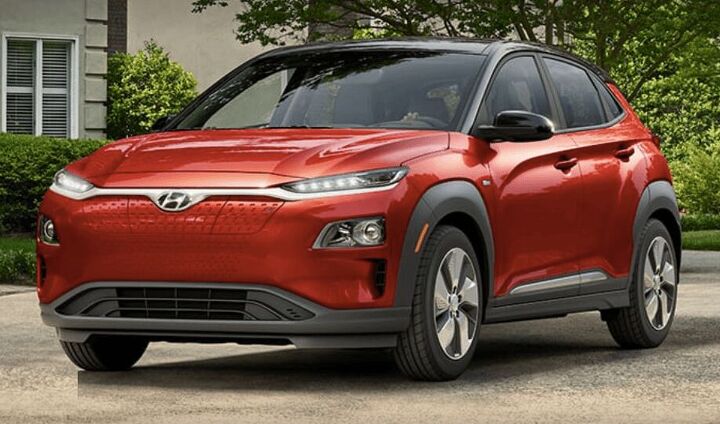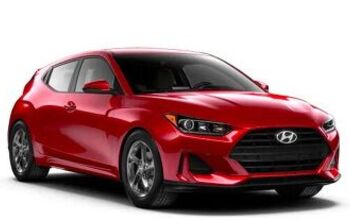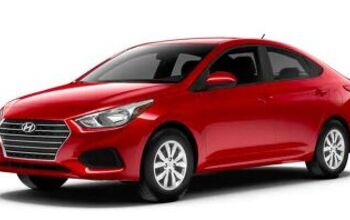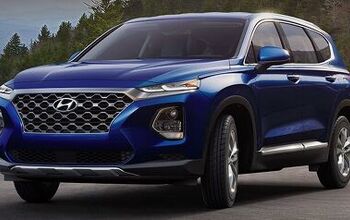Ace of Base: 2019 Hyundai Kona Electric SEL

Earlier this week, Mazda hauled the covers off its MX-30, an EV with more than a hint of RX-8 and MX-5. The company’s decision to imbue the trucklet with clamshell doors and a jacked-up posture cements two things in your author’s foggy mind: first, EVs are here for good; second, most of them will be shaped like pseudo-offroaders.
Which got me thinking about the Hyundai Kona. Available in many trims (including a base model we’ve profiled here before), it is also offered in EV form, bearing less grille than the original Infiniti Q. With three trim levels in the order books for this Korean electron eater, is the cheapest one a customer’s best bet?
We’ll start by observing that the Kona Electric is not cheap in any form, with this entry-level SEL hoovering a stiff $36,950 from one’s bank account. It takes green to be green, apparently. From there, it’s a $4,000 walk to the mid-level Limited and a further $3,500 to upgrade to the snazzy Ultimate model.
The SEL is hardly a stripper, packing safety nannies like forward collision avoidance assist and lane keeping. Blind spot warning dross is expected at these prices and is indeed included. A too-funny driver attention warning system is simply a picture of a coffee cup with lines under it, for those who are wondering.
Powering all Kona Electrics, regardless of trim, is an electric motor zapping out 201 horsepower. That is indeed a lithium-ion battery hove under the chassis (some manufacturers put lead-acids in their entry-level EVs) with a system capacity of 64 kWh. A jumbo 100kW Level III quick charger should replenish 80 percent of its juice in about an hour. Note the Kona is front-wheel drive and does not (yet) deploy a rear motor to power the wheels back there. Maybe in the next iteration, if rumblings are correct.
Kona Electric definitely moves the “rolling science project” meter but does not peg it like the old Nissan Leaf. Its grille-less fascia looks markedly different than a gas-powered Kona, featuring an odd checkerplate pattern that reminds your author of the mudflaps on his father’s 1978 Chevrolet Blazer.
Eagle-eyed EV spotters will know you’re rocking a base Kona Electric thanks to its white roof and mirrors, not to mention the projector headlamps and 17-inch alloys. These styling decisions aren’t enough to spoil the vibe but there’s little chance you’ll lose this thing in the mall parking lot. Besides, you’re parked at those free recharging stations by the door, anyway, right?
Given the price spread and dubious value of features added by moving up the food chain (leather seats, moonroof, slightly larger infotainment), there’s little doubt the SEL represents the best Kona Electric value. Is it the best small EV value overall, though? Your author will find out next week when he tests it against a handful of its competitors.
[Images: Hyundai]
Not every base model has aced it. The ones which have? They help make the automotive landscape a lot better. Any others you can think of, B&B? Let us know in the comments and feel free to eviscerate our selections.
The model above is shown with American options and priced in American Dollars. Your dealer may sell for less.

Matthew buys, sells, fixes, & races cars. As a human index of auto & auction knowledge, he is fond of making money and offering loud opinions.
More by Matthew Guy
Latest Car Reviews
Read moreLatest Product Reviews
Read moreRecent Comments
- ToolGuy TG likes price reductions.
- ToolGuy I could go for a Mustang with a Subaru powertrain. (Maybe some additional ground clearance.)
- ToolGuy Does Tim Healey care about TTAC? 😉
- ToolGuy I am slashing my food budget by 1%.
- ToolGuy TG grows skeptical about his government protecting him from bad decisions.


































Comments
Join the conversation
I was recently in a Kona. It feels like the value brand at the grocery store. Nothing wrong with that, but nothing special either. I remember the door handles being made out of cheap plastic.
Dealer update: I clicked on a B&B link related to Hyundai incentives and ended up with a Hyundai test drive incentive (free gift card). You had to choose a vehicle - I went with Sonata. - No 2.0T's in stock. Test drove a Limited. - The dealer tried hard to sell me a Volkswagen. What???